Back in 2018, when John Herdman took over as manager of the Canada men’s national team, he said the ambition was to qualify for the 2022 World Cup to lay the foundation for the 2026 World Cup (co-hosted by Canada, Mexico, and the United States). At the time, some might have questioned if the new head coach was setting the bar too high, given CanMNT has not participated in the competition since 1986.
Time flies and four years later, we can see that dream is on the verge of becoming a reality with three rounds to play. Canada topped the 2022 World Cup Qualifying CONCACAF group in the third round, four points clear of Mexico and the United States. The positive results give the whole country a healthy dose of hope in football, and now it appears as though they have a very high chance of going to Qatar in 10 months.
This analysis will explain Herdman’s tactics at CanMNT by considering his principles of plays based on contexts, including the opponents and the players available for selection. We must say Herdman is a very flexible coach who can adapt the team according to circumstances, sometimes adapting their tactics multiple times within a game.
Formations
Consett-born Herdman didn’t have a professional playing career in football, but he was an academy coach at Sunderland while studying and lecturing part-time at Northumbria University. His CanMNT play in a traditional 4-4-2, not quite exactly in a 4-D-2 as often described. However, in terms of playing style, Herdman also fits the trend of modern football, we shall be explained more in the tactical analysis.
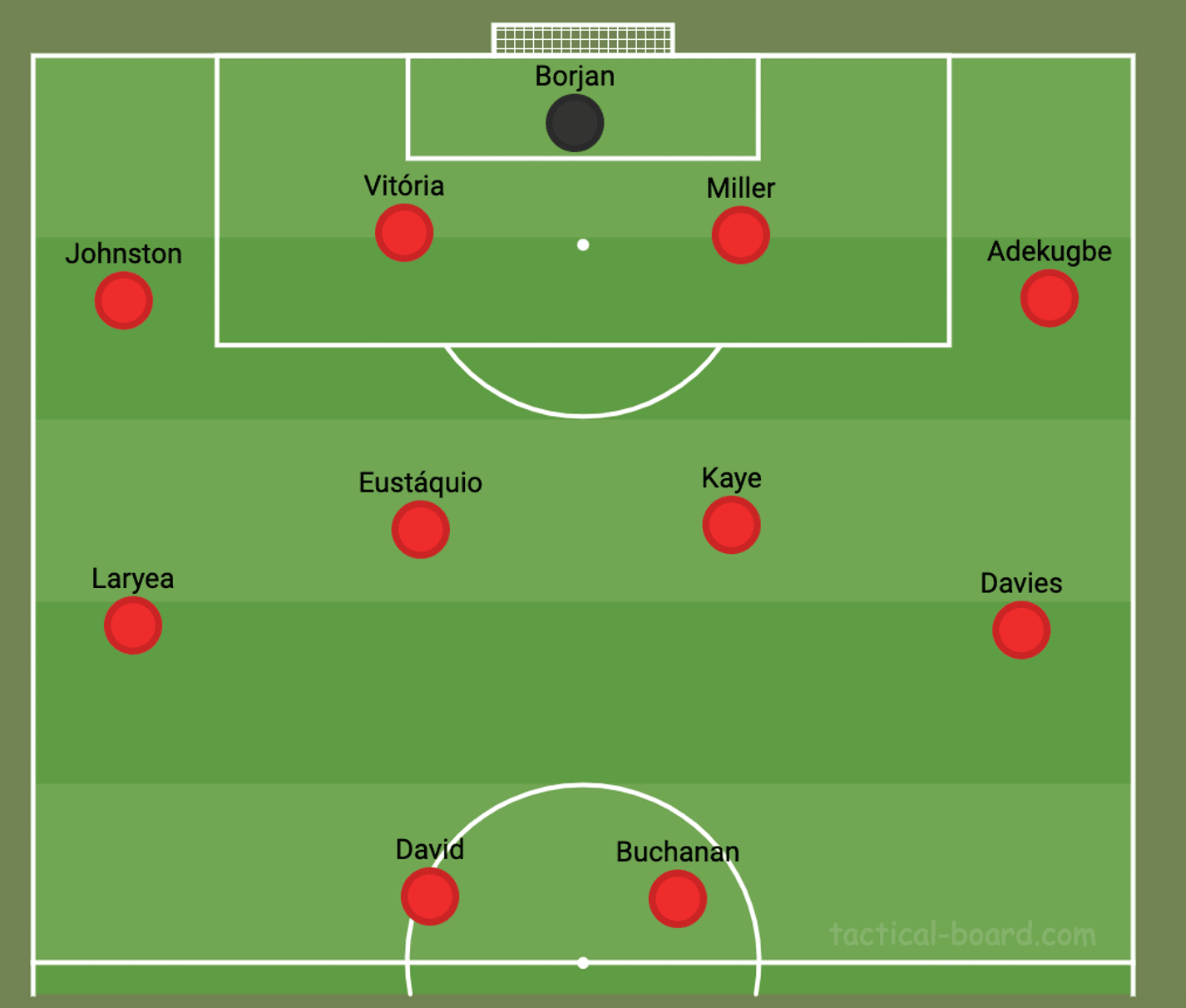
Herdman has made reliable and consistent choices at the CanMNT. In a back four, Kamal Miller and Steven Vitória have often been the starting centre-backs, with Sam Adekugbe and Alistair Johnston playing as the full-backs. In the midfield, Stephen Eustáquio and Mark-Anthony Kaye are the first choices but the experienced Atiba Hutchinson and Jonathan Osorio also fit in those positions well. Against stronger opponents, Herdman would prefer Richie Laryea on the flank. The 27-year-old Nottingham Forest player can flexibly shift between a wing-back and a winger with and without possession. Alphonso Davies is the preferred choice as the left-winger, but Herdman believes the Bayern Munich star can play in several outfield positions if required. We’ve put Jonathan David and Tajon Buchanan’s name on the sheet as the strikers, but Cyle Larin is also a reliable option if more physicality and prowess are needed at the top while Buchanan might go to the flanks to find more spaces.
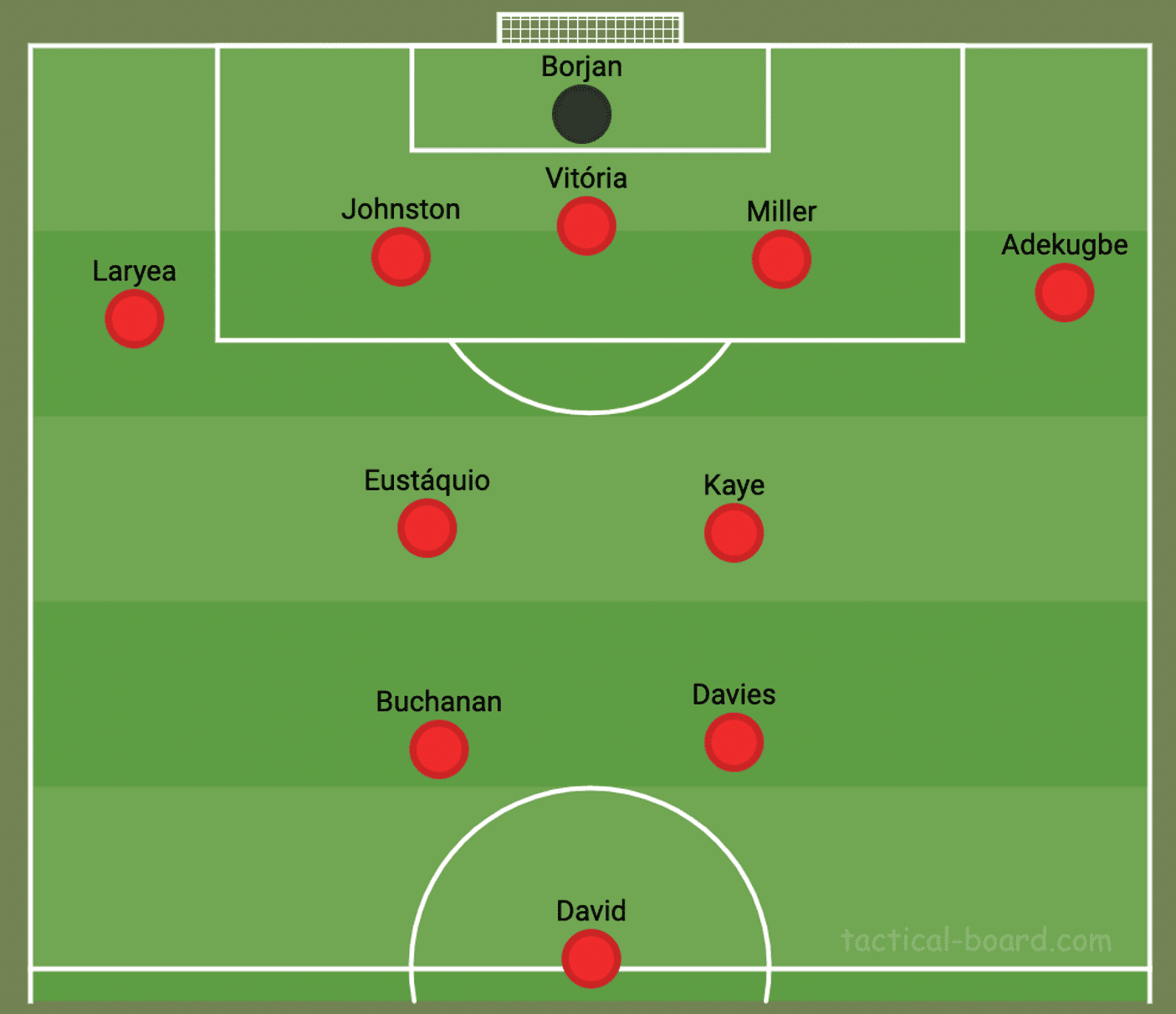
Against tougher opponents, such as the USMNT, who also have a group of flourishing attackers like Christian Pulišić and Brenden Aaronson, Herdman would opt for a back five to sit in a deeper block, allowing the team to harm the opponents in the transitions from defence to attack (TDA). However, it’s not only a 5-2-3 or a 5-4-1. Instead, 5-2-2-1 might best describe Herdman’s back five as there is no far side player in the pressing. In the block, the front five must be sticking together as a group to block spaces in the centre, especially as the far-sided winger ought to be staying inside. We would delve into more details of how Canada played without possession later.
Quick and smart attacks
The World Cup Qualifying in CONCACAF is a very interesting competition. For CanMNT, they could face teams who have less potential to harm them in the open plays such as Costa Rica and El Salvador, but there are also teams with top players like the USMNT and Mexico, pressing with more intensity in higher areas.
Therefore, CanMNT must be clever to adapt their tactics, being more cautious against USMNT and Mexico, but also have the courage to attack other teams in the group stage. Herdman doesn’t force his side to build up with short passes like Barcelona or Manchester City as the players are not quite fit for this playing style. Instead, they have to be smart and confident to play with more direct plays, but that does not mean playing long balls to the striker blindly.
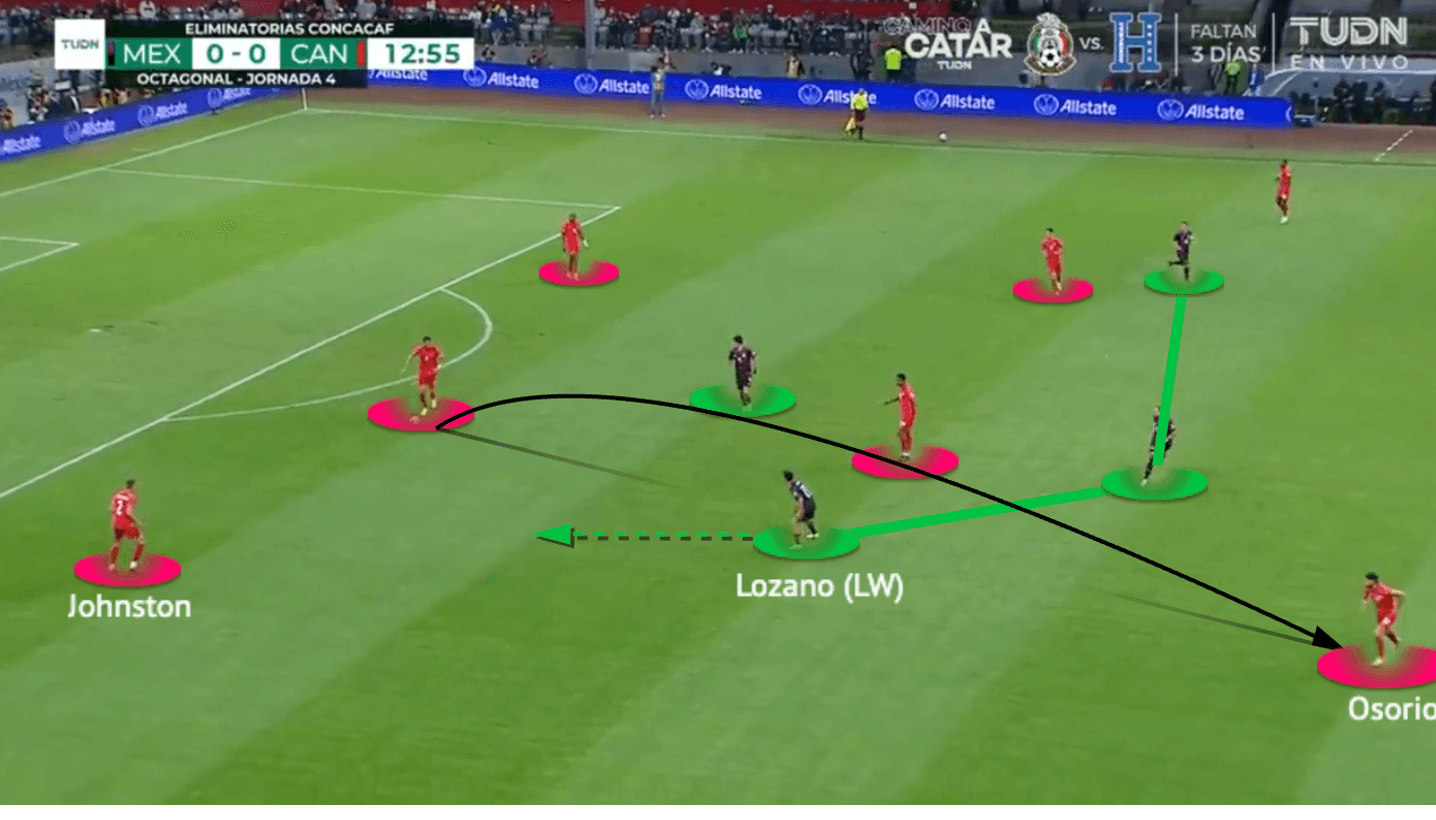
Regardless of the chosen formation, Herdman prefers his team to form a three at the back in the build-up which would give his side more central presence to close spaces in the transitions from attack to defence (TAD). From an offensive point of view, a back three has a higher chance to pull the opposition wingers out to create spaces behind them, so the centre-backs could spot the free player behind the first/second line in the build-up. Manipulation of the opposition winger is the key to the attack progression.
In a 5-2-2-1, the build-up with this formation is natural. In a back four, the right-back (Johnston) often tucks inside as the right centre-back so there was the shape. For example, they played with a 4-4-2 in Mexico and Johnston would not go high and wide, since he mostly stayed deep in the first line. By doing so, he fixed the opposition left-winger’s attention and drew him high, allowing Vitória to loft the ball to Osorio behind the second line.
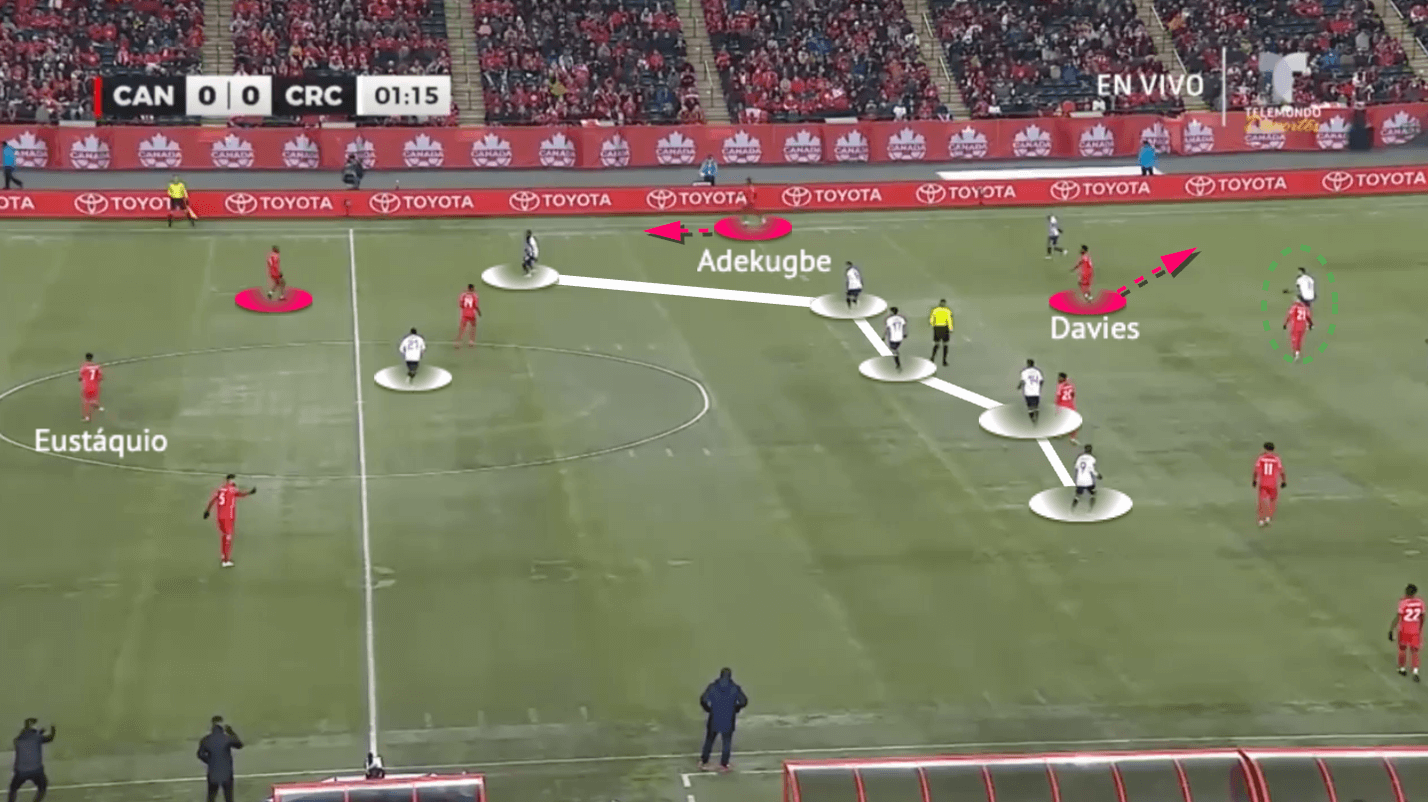
Against Costa Rica, a game in which CanMNT committed more players high to attack in the opposition half, the back three was not created by the full-back. They don’t need five deep players in the construction here, so Eustáquio dropped instead to create the shape, as we drew in the second image. The Porto midfielder was like an instructor to his teammate, who had a good understanding of the game to dictate the rhythm. This also allowed both full-backs to play higher and wider to provide the maximum width, stretching the opposition backline horizontally, so the likes of Davies and Buchanan had more space in the centre.
This time, the deep left centre-back invited the Costa Rica right-winger to press, so Adekugbe became free on the flank. If the opposition 8 moved out to close the Adekugbe, then the vertical passing channel in half-spaces was vacated to find Davies.
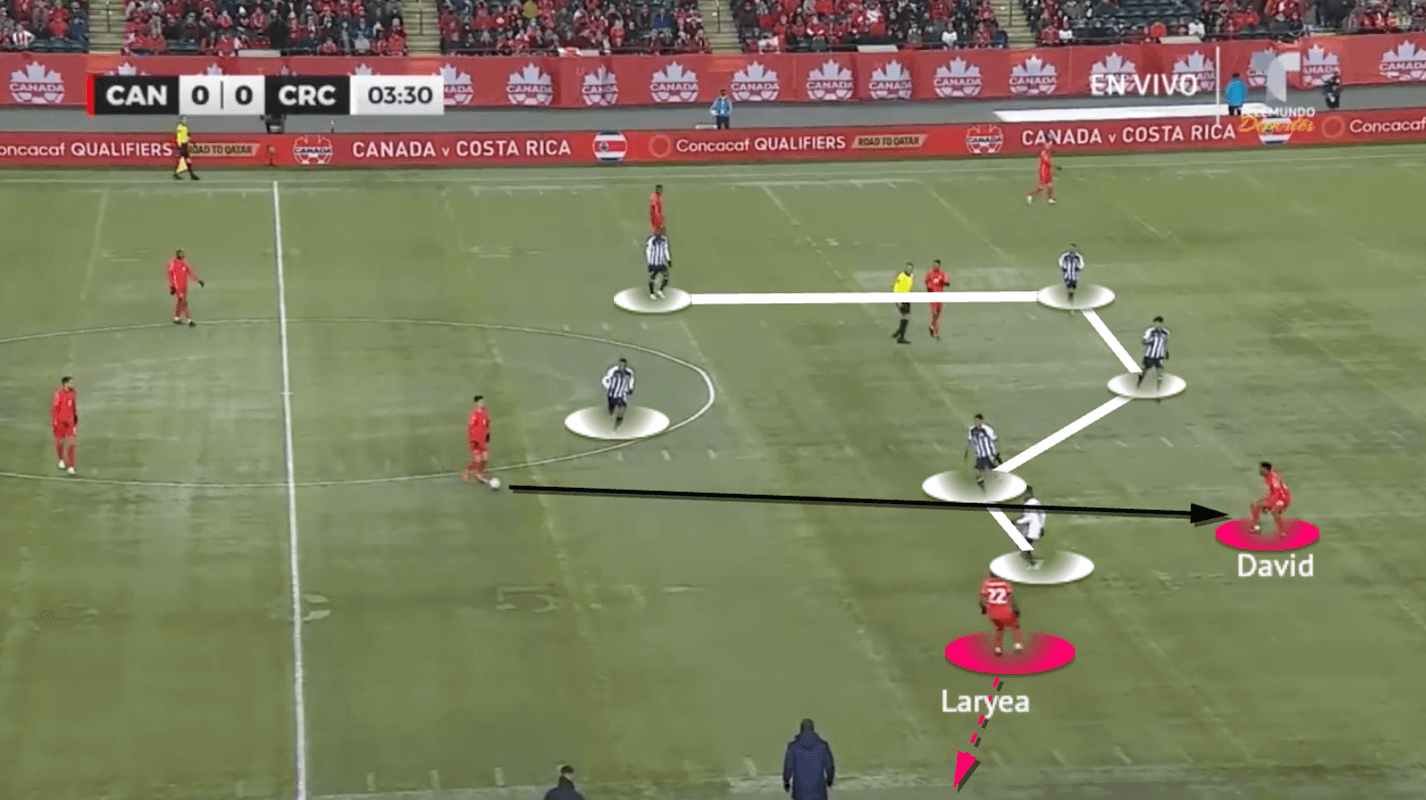
Apart from using the deep position of the full-back to draw the opposition winger out and unmask a passing lane in the half-space, they could also drag the winger out by the full-backs’ movement. Here, Laryea intentionally stepped wider to offer himself as a passing option. The chain effect of such a move was that it provoked the opposition winger to mark him, but that created another solution for the ball carrier as the passing lane into the half-space was now unmasked.
David, the young attacker from Lille, is a creative source of the team because he has the flair, composure, technique, and the inspiration to roam in the final third, making things happen unexpectedly. So, while playing with a two-striker system, there could be two false-9s (Buchanan, David, or Osorio) to exploit spaces between the lines. Only Larin typically acts as a more conventional striker.
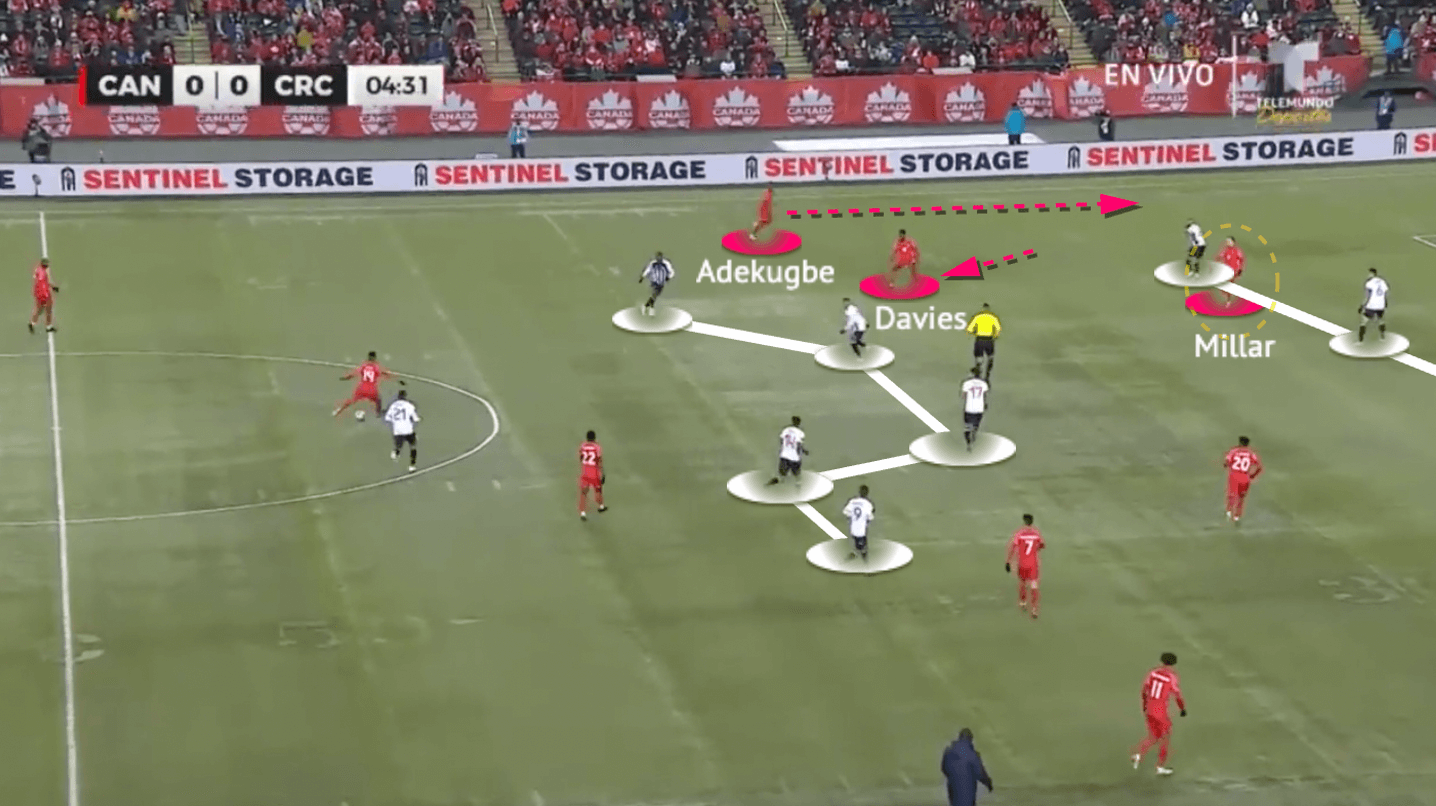
With opponents against whom Canada could control the game more, they preferred to attack slower so the TAD is controlled better as well. In that case, they have a structure with clear intentions to create a stronger and a weaker side to construct the attacks. Davies would be a bit deeper and more central in those games to receive, while against Mexico and USMNT, the opposition held a high line so Davies stayed higher to exploit the open spaces behind with his explosive pace. Also, when Buchanan played on the right side, CanMNT would like to vacate more spaces on that flank because the Club Brugge winger could carry the ball vertically with so much pace all the way to the byline to cross. Isolating Buchanan also fit the deep right-back tactic as Johnston was not required to go forward to help the winger.
Hence, the striker should also go to the ball side to pin the corresponding centre-back. With a high left-back like Adekugbe to manipulate the opposition full-back, Davies has a higher chance to be freed in the half-spaces, although CanMNT prefer playing long diagonals into spaces behind instead of going between the lines.
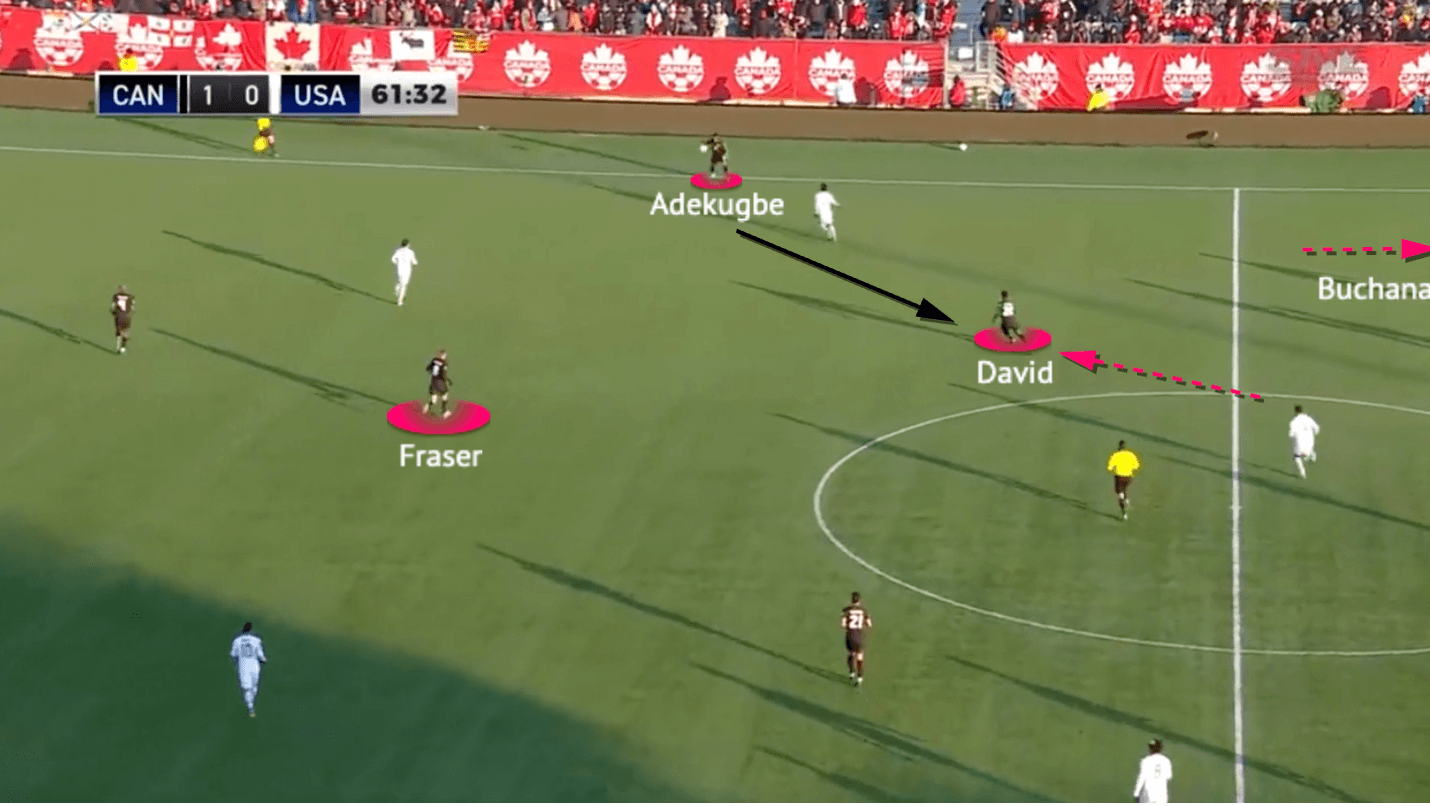
If playing with a 4-4-2, they actually had an interesting four-man structure in the formation to help the full-back on the ball. As shown in this example against the USMNT, Adekugbe was given three options, including the 6 (Liam Fraser – lateral), the striker (David – diagonal), and the quick winger (Buchanan – vertical) going behind the last line. The runs in behind the last line must be presented because they give the full-back an option to go long without taking risks by going short into midfield when the opponents pressed high.
Recalling Larin’s goal in the USMNT draw in September, it was also attributed to the same concepts with Davies dashing behind the last line, outpacing DeAndre Yedlin to provide the assist.
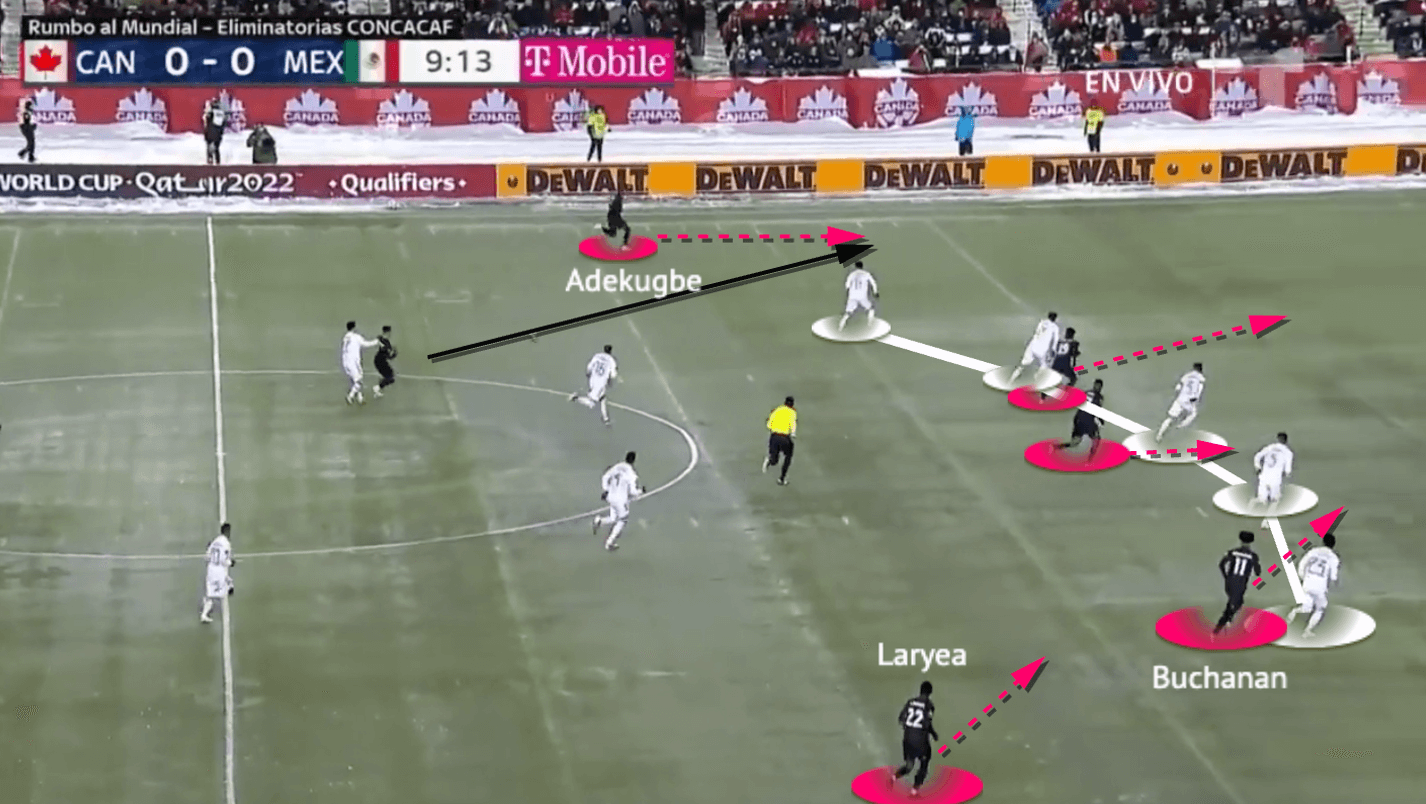
Against stronger opponents, when CanMNT break lines into the middle third they must go all the way into the final third instead of stopping and circulating again. In those situations, the attackers would also be attacking spaces behind with a run as shown in the last example of the section. Davies, Larin, and Buchanan shared the collective mindset. However, whether the far-sided full-back should go high was questionable. Since Herdman wanted to minimise the open spaces in the centre during the TAD, as Laryea’s movement shows above, the far-sided full-back might be required to provide balance in the midfield, rather than go into the spaces behind.
Anyway, in the final third, CanMNT rely on the individual abilities of attacking players to make things happen. Apart from the talents, presence in the penalty box is also important, as they’re a team that likes to create chances through crossing from the bylines.
Defend together as a team
Canada’s attack is very flexible and adaptable to the opponents depending on where the weaknesses are shown. Comparatively, Herdman has a more consistent approach when the team is without possession that could be applied against different sorts of opponents. Of course, the height of the last line and the engagement line still have a strong correlation to the opponents.
Sticking as a unit to maintain compactness is the most important principle, but how exactly do they do it? We will explain the CanMNT’s defensive style of play in this section.
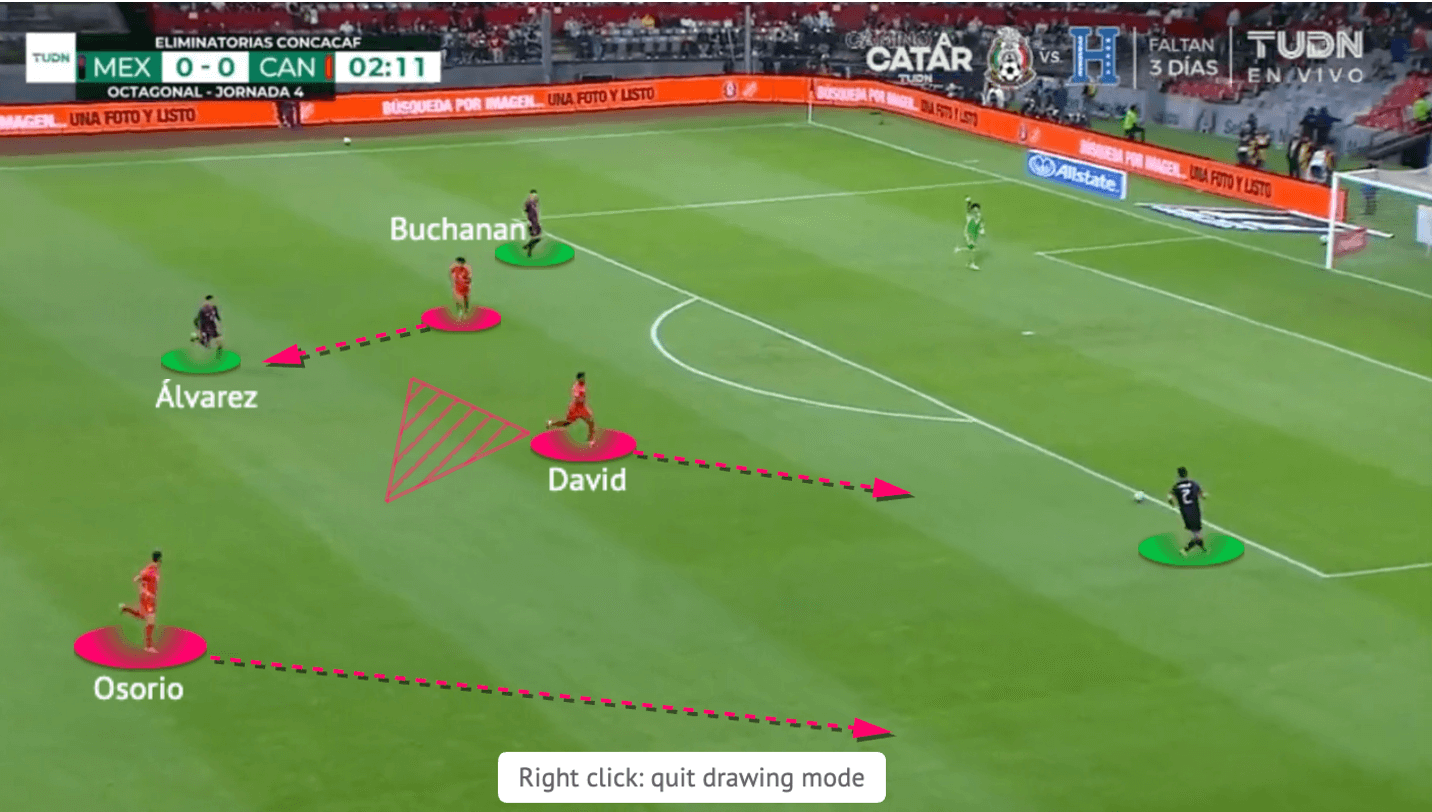
The defensive shape of Canada has varied between a 5-2-2-1, a 4-4-2 and a 4-1-3-2. In these games, they had two strikers against a 2-1 build-up shape and they did very basic “pressing & cover” in the high pressing. That means the utmost importance of the first line was to cover the opposition 6 and spare one of the strikers to press on the respective half.
For example, Gerardo Martino’s Mexico played with a 2-1 or 3-1 shape with Edson Álvarez as the 6. In this image, David was trying to keep Álvarez in his cover shadow and Buchanan was dropping back to approach. They were happy to let the opponents play around him, but not inside the CanMNT block. Meanwhile, the wingers, who stayed in the centre to close that space initially, only jumped out to press the full-back if they received (Osorio). This diagonal pressing must not be done too early or else the opponents could play vertical passes into the half-spaces. The full-backs mostly oriented themselves with the opposition wingers, so you would not see them travelling huge distances to press the full-backs.
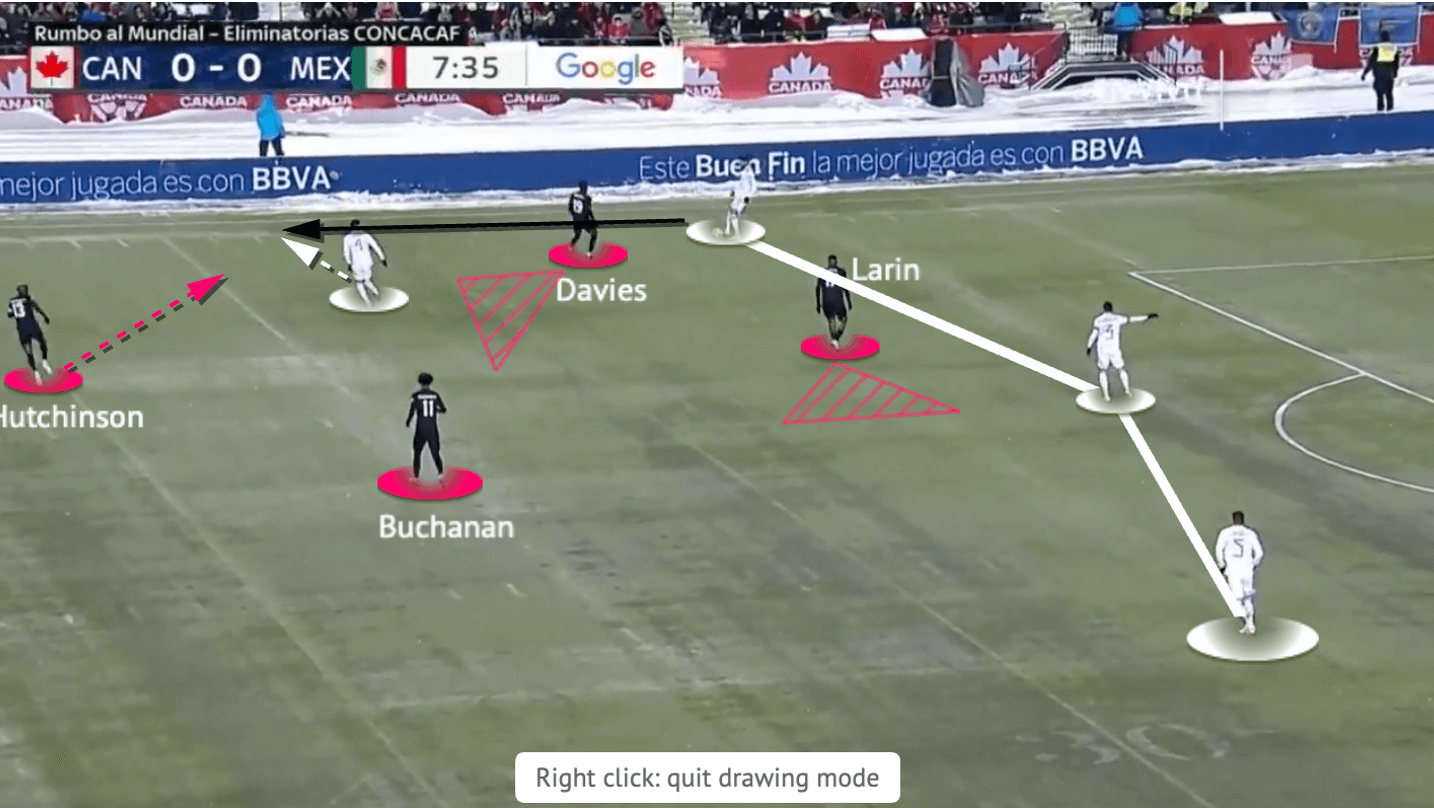
But Canada played with a 3-4-3 against Mexico and without possession, it was a back five with the front four/five pressing only. The striker mainly stayed in the centre to cut the passing lanes to the other side, while there was no winger without possession because Davies and Buchanan were more like a pair of 10s in the centre. Hence, the angle of the press could become diagonal instead of vertical, inviting the oppositions playing down the flanks where CanMNT could press with the sideline.
In this reverse fixture between Canada and Mexico, as shown here, the far-sided winger must not detach from the block. He must be in the centre to maintain compactness. The significance of this was far more than a defensive positioning because when the ball came in, that far-sided 10/winger must try to win the ball back with the collaboration of the 6s, so that could be a central trap with two angles of pressure. Of course, that happens less frequently because the opponents don’t often slice the diagonal pass into spaces behind the striker.
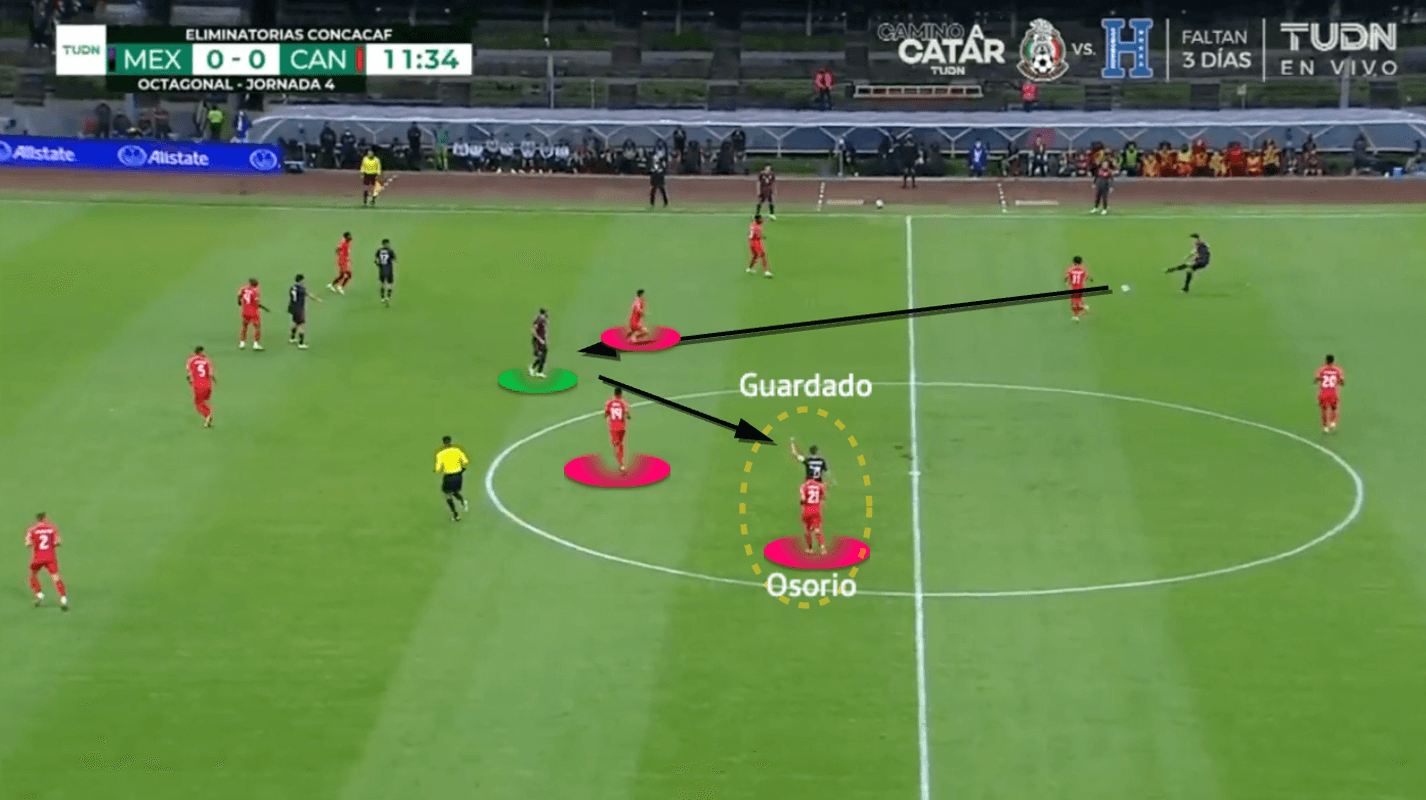
But that could be a very important tactic in the midblock, especially against teams playing with three midfielders like Mexico. In CanMNT’s initial setup, they only had two midfielders, to balance the number in the centre, adding the far-sided winger is a good solution. In this example, Osorio’s position was good because he was tight enough on Andrés Guardado.
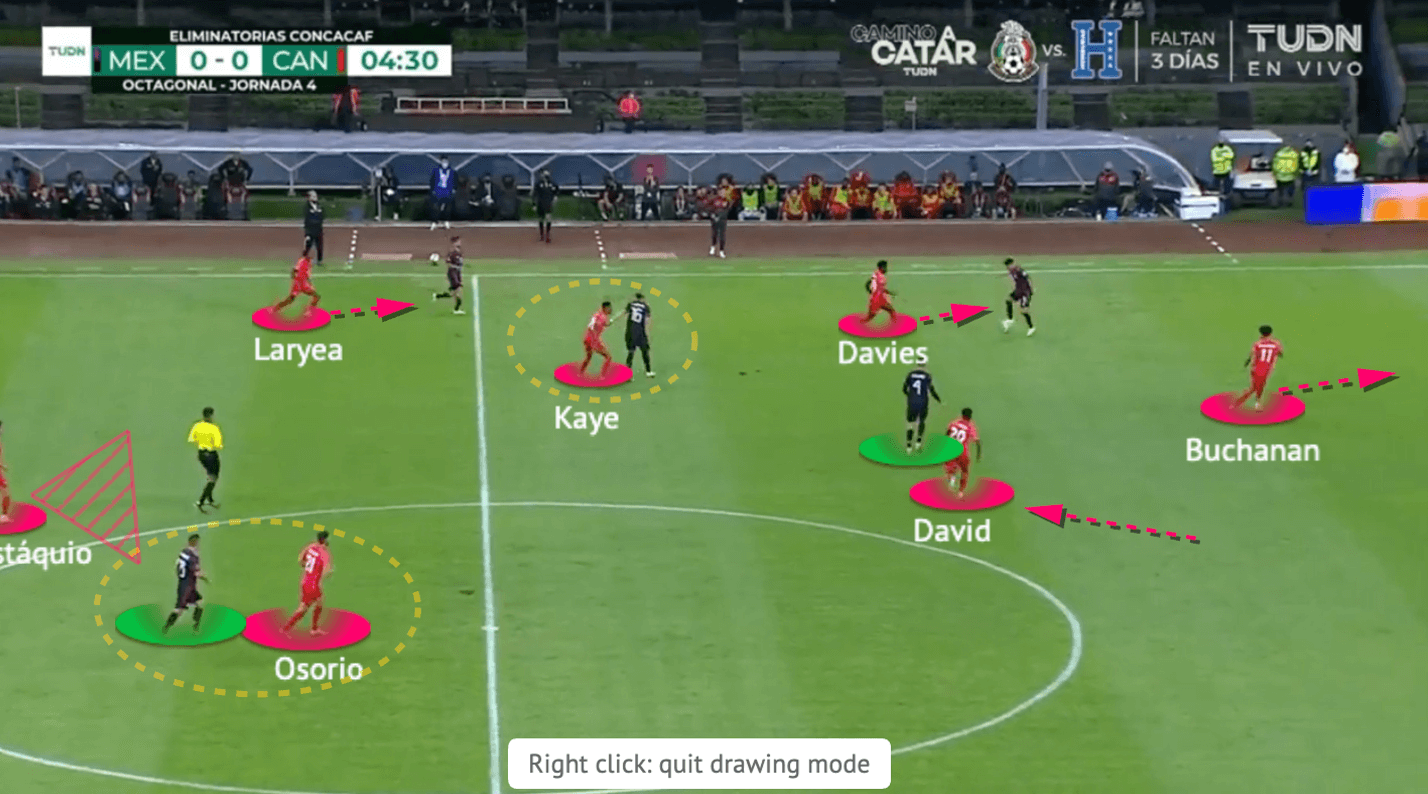
In a midblock, the far side winger’s positioning has a very important impact. CanMNT usually want to invite the opposition to play on one flank, before then using that as a side trap to net the opponents and recover possession. The above example shows another example of Canada’s midblock defending.
On the ball flank, Davies engaged the ball, while the strikers also did something similar to the “pressing & cover” concept. Buchanan was higher to bait the return passing lane, if the Mexican player went back to the centre-back, the ball shall be intercepted and CanMNT could counter-attack. Meanwhile, the far side striker, David, went inside to cover Álvarez, so Mexico could not slice the ball diagonally into the 6 and play through the centre.
When the opponents entered the ball side, the marking must be tight to make sure there’s no room to receive or turn. Hence, the full-back must track the winger very tightly without thinking about another player to mark, while the ball near midfielder must step up to close the opposition 8, as Kaye did above. To balance the shape, as Osorio’s position indicated here, they closed the centre by tight marking. Usually, they also had one midfielder deeper to cover spaces behind the press, ideally, that was Eustáquio because the Porto man could read the game well, and allowed Kaye, who had a better physique, to mark the 8 tightly.
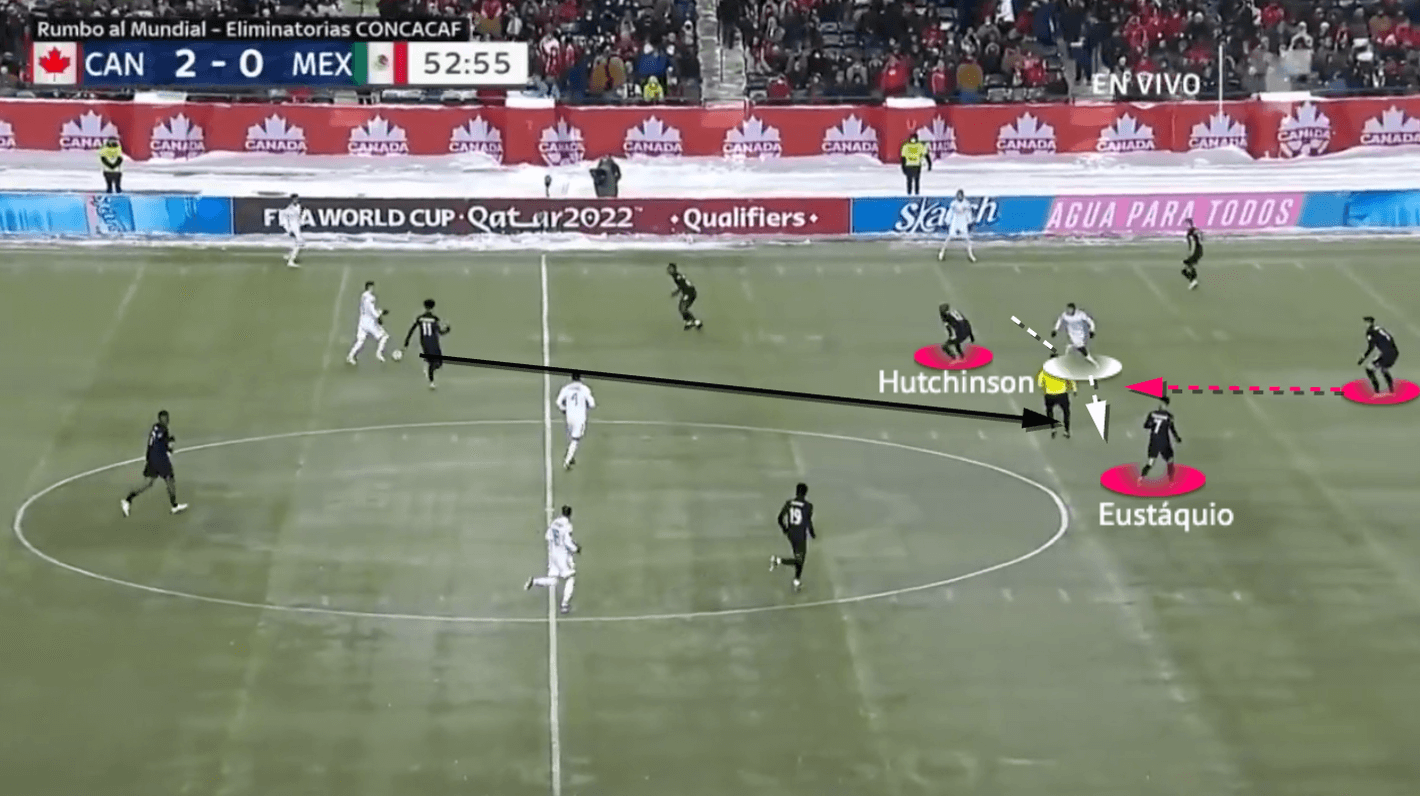
In addition, Canada’s players are very good at “forechecking”, which means to intercept before the ball arriving at the receiver’s feet — the players have a very good mentality and are aggressive to step up when the passes come in front of them. This is a good way to trigger counter-attack opportunities which we are covering in the last section.
From a defensive point of view, the defenders need to be brave in closing spaces in front. Sometimes the opponents would sneak behind the CanMNT midfield to receive in the centre. For example, the Mexican player moved behind Hutchinson here, and the centre-backs stepped up to close the receiver. But even though the initial attempt was unsuccessful, CanMNT could continue the press because they have players around, close enough to support each other. Here, Eustáquio closed spaces very well and his clever positioning was a valuable asset to the team.
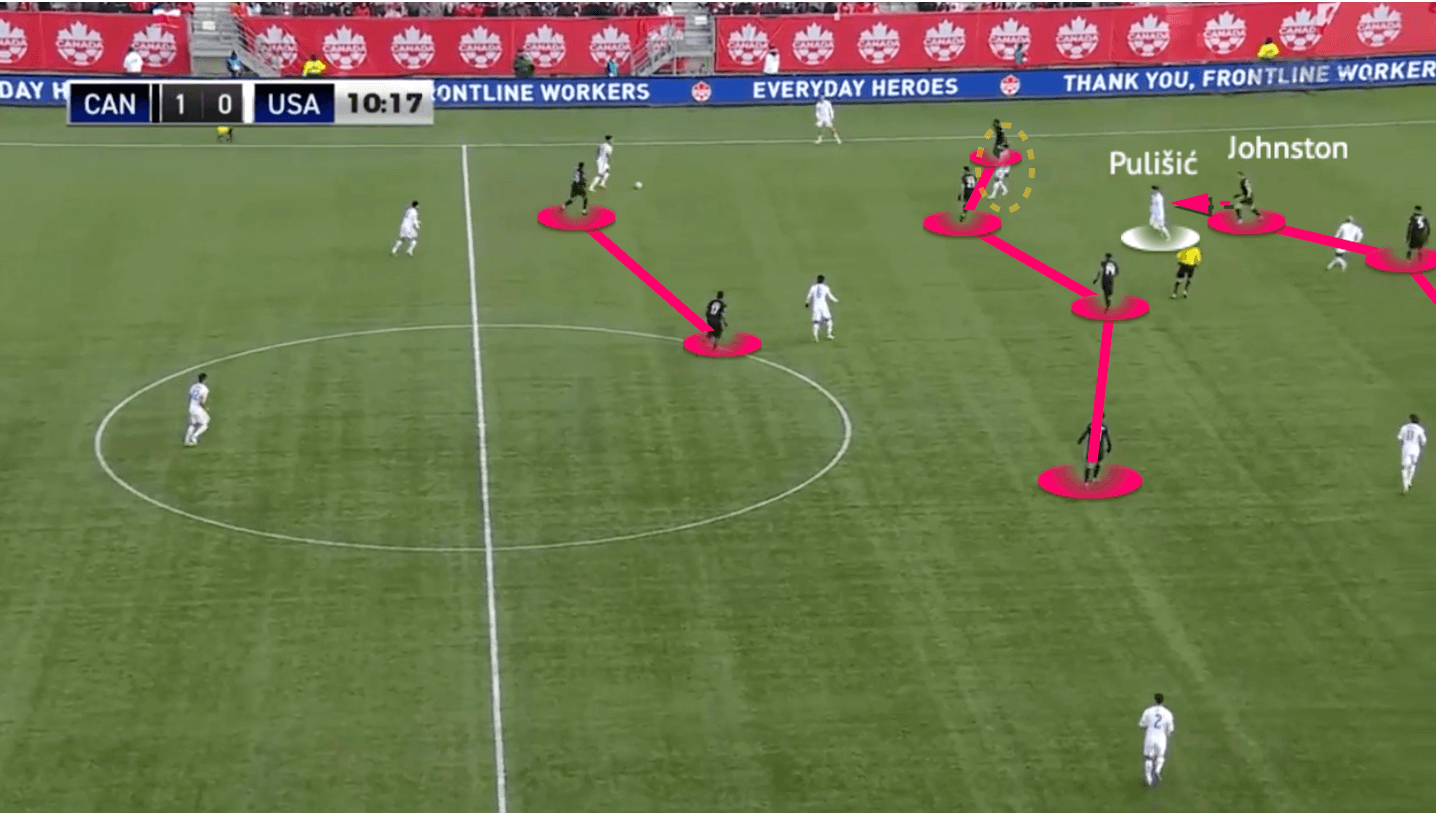
Games against the USMNT were more complex because the opponent had many flank rotations involving a full-back, a winger, and an 8 or even with the 6 sometimes. This was something Herdman’s ball side man-oriented approach could respond well to because the players did not have to think too much. This was a clear guideline for the players to know who is responsible for which opponent, and stay tight to make sure the receiver could not turn easily by any means.
In the above image, Pulišić dropped into the half-spaces while the USMNT 8 was behind the second line. If the system was zonal, Johnston might be confused and leave Pulišić free because there was another player (a 1v2). But that is not happening in Herdman’s CanMNT because the principles of defending are very clear. The players knew what to do and how they executed was excellent.
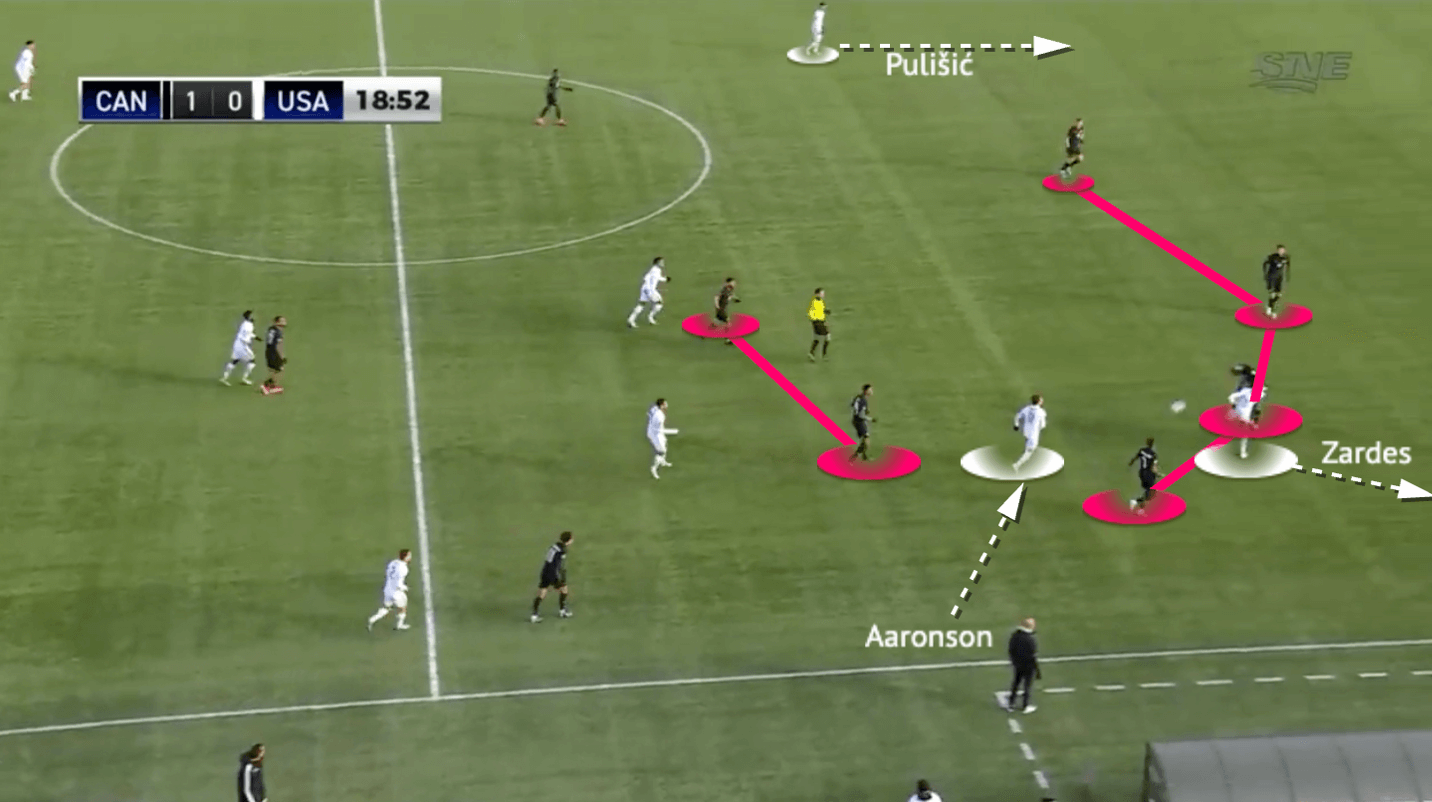
Of course, just like every team in the world, CanMNT aren’t without their weaknesses. For example, they are quite vulnerable against the long balls and the second ball recoveries. When the first line was not pressing, sometimes they were stretched by the opponents with the midfielders being drawn high. Then, a diagonal switch or a direct play could expose the backline in the second ball actions, they conceded a goal to Mexico in that way, and USMNT also created chances through similar methods.
The above image shows an example of USMNT’s attack, which shows an example of an occasion on which the Canada full-back might be perplexed about who to track, given the direct plays were more chaotic and difficult to judge the direction of the ball. As Aaronson went infield, Adekugbe was confused whether he should cover the striker behind Miller or stay tight with the RB Salzburg man. Since the CanMNT 6 was high initially, they could not recover the second balls and allowed Aaronson to further carry the ball inside. Pulišić also had more space to play because it makes sense for the right-back to stay narrower, and those switches were something Canada could not handle very well and their opponents could exploit.
Mastering the transitions
Although Canada have very talented attacking players such as David, Buchanan, and Davies, it is never an all-out-of-attack approach from Herdman because keeping the defence in shape is important too. Football is not only about constructing an attack and the defensive organizations, the transitions also matter and CanMNT are quite impressive in both TAD and TDA.
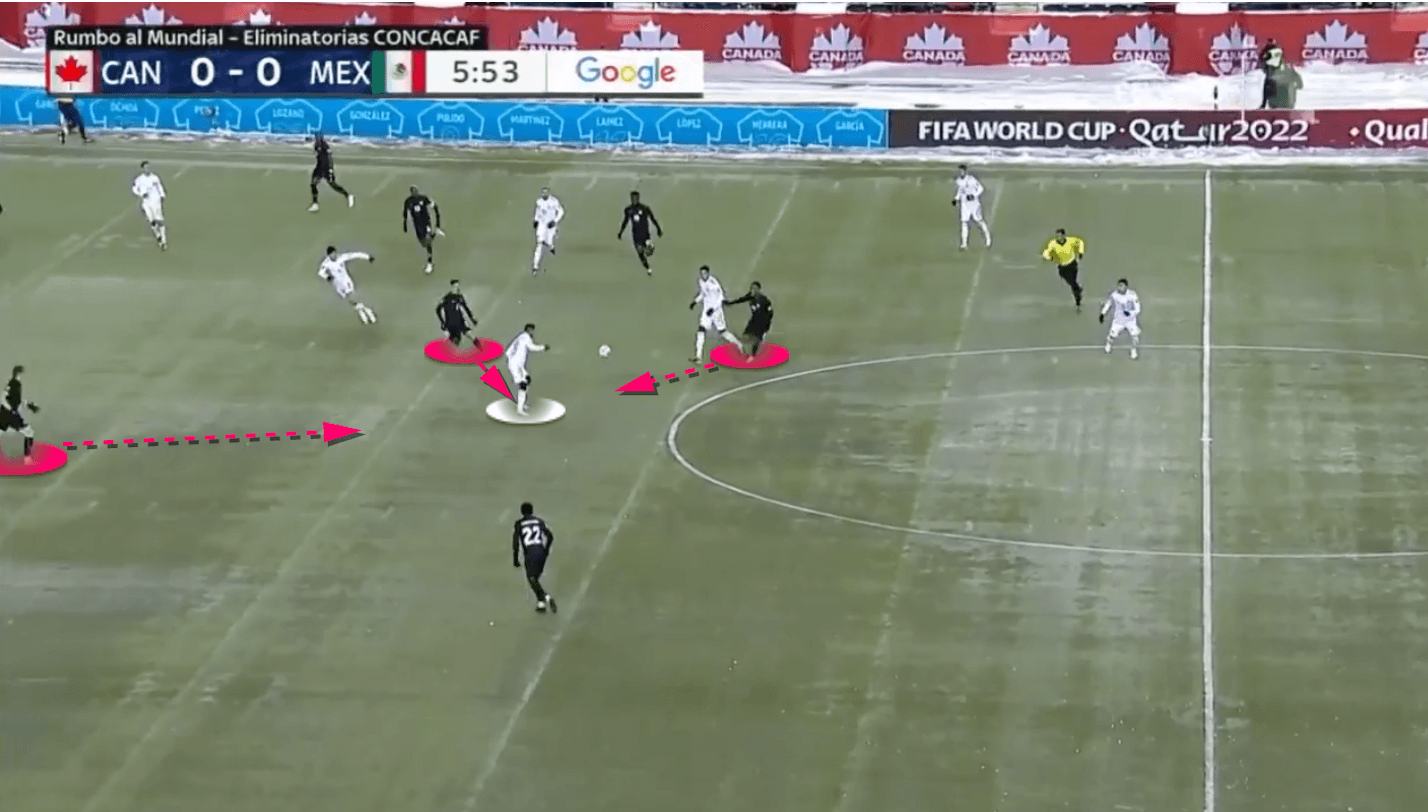
In TAD, Herdman gives the players so much confidence to counter-press in a ball-oriented manner. It is simple and easy to understand, the Canadian players just had to attack the ball together and try recapturing it.
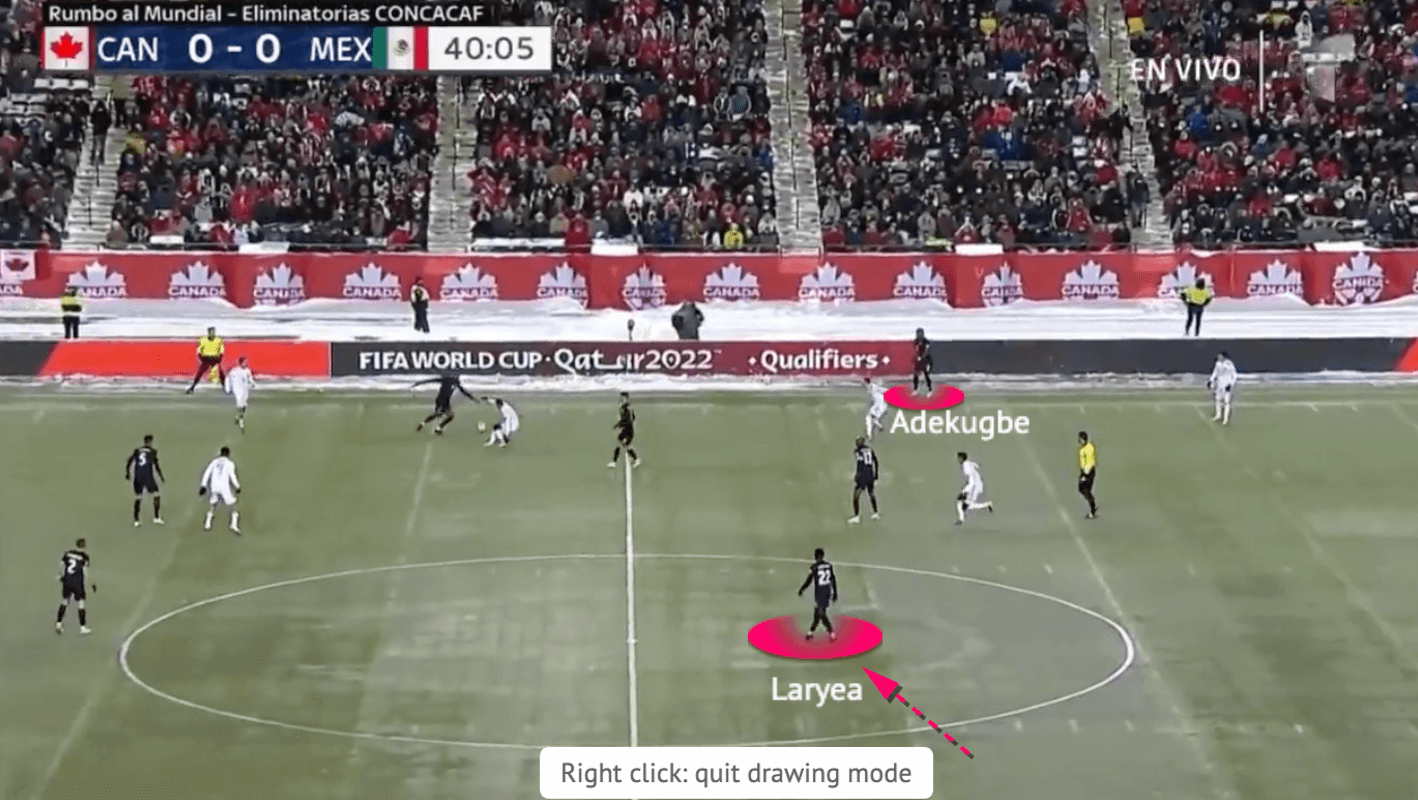
Furthermore, Herdman’s football demonstrates a good example of how to think about defending when the team is in possession as well, and not many national teams would have set up their offensive structures in that sense. It was a very logical process because the moment you lose the ball, what matters is how you organised yourselves with the ball, it was the prerequisite that determined how much space (or which space) to defend during the TAD.
Hence, Herdman’s use of full-backs/wing-backs is very interesting. We mentioned how Laryea and Adekugbe fly high and wide simultaneously to stretch the pitch but that is not a must. If they encountered a stronger side, the wide defenders might be asymmetrical so they concede fewer spaces in the TAD. It means when they were attacking from one flank, the wide defender on the opposite flank should come inside to set up a compact rest defence structure. They don’t need the width on both flanks, in that case, only minimum width was required. You could tell from Adekugbe and Laryea’s position in this picture.
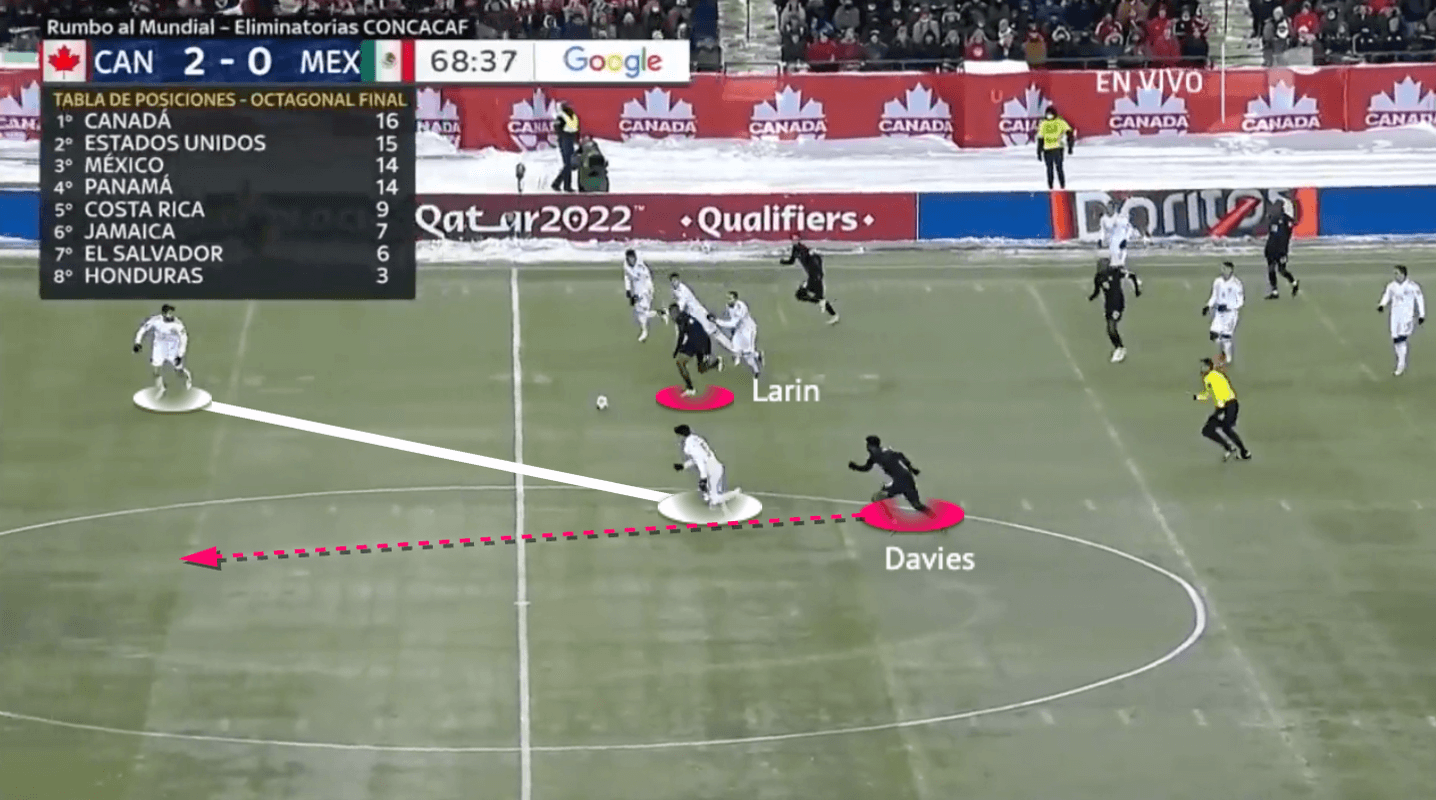
In the TDA, CanMNT carry a great threat because their attackers are very good at attacking open spaces. Actually, the likes of Davies and Buchanan are better in such spaces because they have very good pace to drive into it. As the winger, they always attack via deep runs at full speed to outrun the opposition.
Structurally, the striker would come a bit deeper to receive, so the first reaction is to find him, which usually attracted the centre-back to press. If Larin could turn, it was all good, but if not, he could also release a third-man to look for the quick runners behind or use wingers as the third man. In that case, the likes of Davies and Buchanan could go inside to attack spaces behind the centre-back or if the opposition full-back came in, they could attack spaces outside of the line to receive behind. In this example, even Davies’ beginning position was deeper than the opponent, it was clear that he could get to the ball first if the pass was made.
Conclusions
As we have shown in this tactical analysis, CanMNT is a well-drilled, disciplined, hardworking, united, and mentally strong team under Herdman. So far, it has been a magical journey for The Canucks Les Rouge in the CONCACAF group. The performances and team spirit shown have been very encouraging. They are now just one step away from Qatar and the world has noticed.

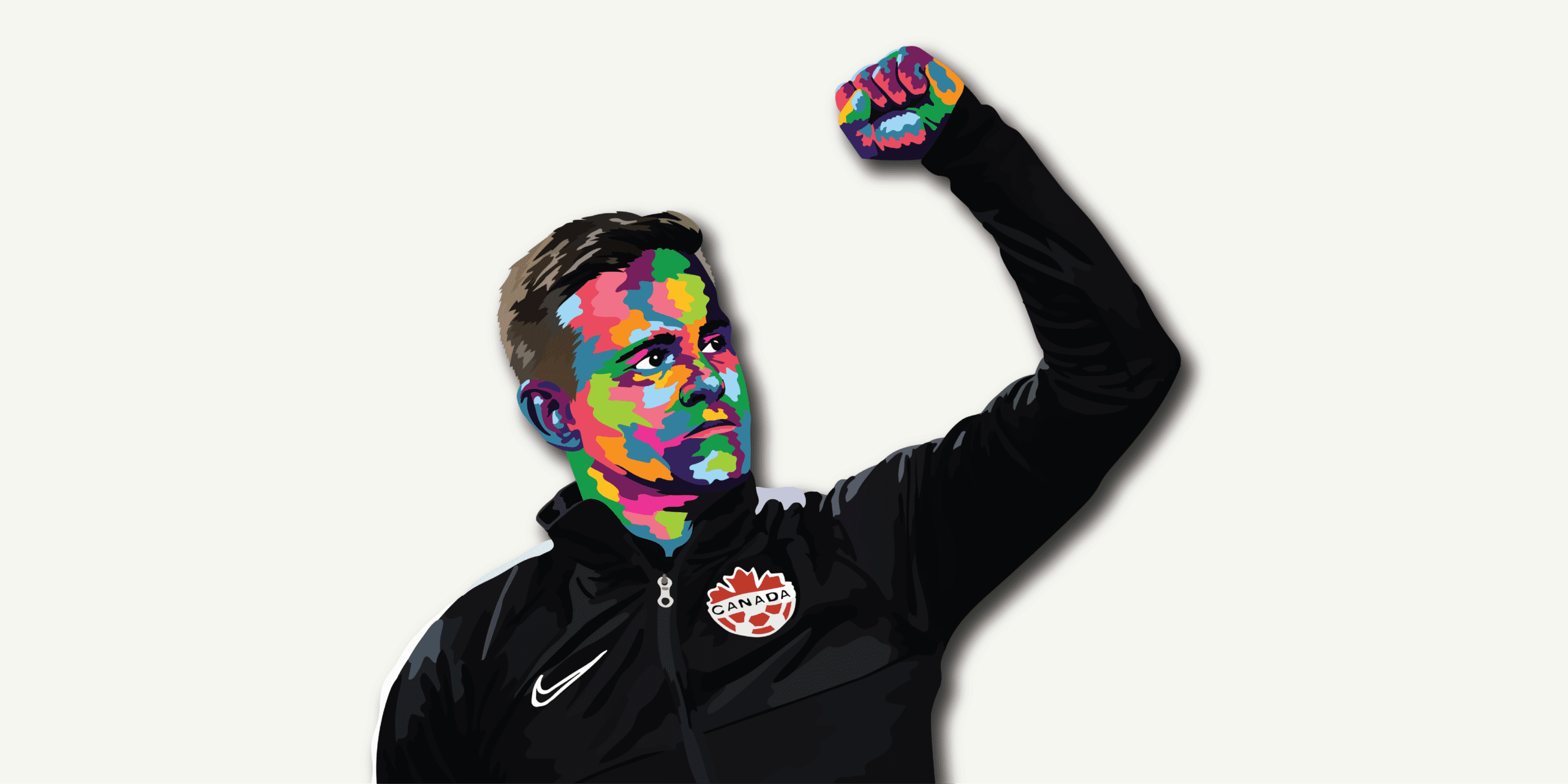



Comments